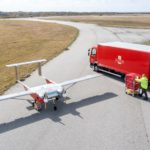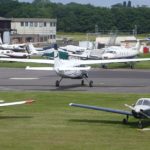Katherine Simmons talks to Ampaire’s Dr Susan Ying ahead of two flight test programmes in the Scotland and south west England
Developments in regional air mobility (RAM) will tackle geographical and economic barriers, as well as helping countries meet their carbon reduction targets, according to Ampaire’s Senior Vice President Dr Susan Ying.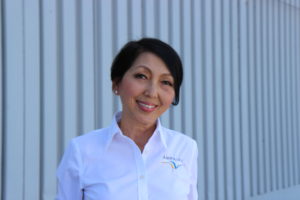
Ampaire is due to start test flights in Scotland this July with the hybrid-electric Electric EEL aircraft, a modification of the Cessna 337 twin-engine, six seater aircraft. The aircraft will fly on regular, 35-mile round-trip flights between Wick and Kirkwall in Orkney. There are currently no regular air services between the islands, which are currently connected by a 1.5 hour ferry ride, a journey which could be shortened to around 20 minutes using the EEL.
The test flights are being run in conjunction with Highland and Islands Airports Limited (HIAL) as part of its Sustainable Aviation Test Environment (SATE) programme. HIAL operates and manages 11 non-profit making airports, vital for the social and economic welfare of the areas they serve.
Improving connectivity for Scottish islands
Feasibility studies will be taking place into the flights and into similar routes to some of Scotland’s most remote communities. Some areas lack sufficient air service because of the high cost of flights operated by current aircraft types. The test flights will enable Ampaire to analyse benefits and infrastructure needs, especially charging requirements, with HIAL identifying how renewable sources can be used to charge the aircraft.
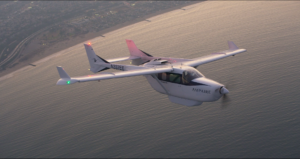 The EEL is a hybrid-electric testbed aircraft, which demonstrates the new technology through upgrading the existing Cessna 337 airframe. The aircraft has been developed to be both hybrid-electric and, eventually, fully electric. It has a conventional engine in the rear, an electric power unit in the nose and a battery pack in an aerodynamic fairing under the cabin.
The EEL is a hybrid-electric testbed aircraft, which demonstrates the new technology through upgrading the existing Cessna 337 airframe. The aircraft has been developed to be both hybrid-electric and, eventually, fully electric. It has a conventional engine in the rear, an electric power unit in the nose and a battery pack in an aerodynamic fairing under the cabin.
Ampaire has been flying its first and second hybrid-electric six-passenger aircraft since 2019. The second Electric EEL aircraft will be brought to Scotland, complete with new tartan wingtips. After carrying out tests in Scotland, the aircraft will travel to South West England for similar demonstrations between Exeter and Cornwall Airport in Newquay in the Ampaire-led 2Zero (Towards Zero Emissions in Regional Aircraft Operations) programme.
The 2Zero consortium also includes Rolls-Royce Electrical, University of Nottingham, Loganair, Exeter and Devon Airports, Cornwall Airport, Heart of the Southwest Local Enterprise Partnership (HotSWLEP), and UK Power Network Services. Like SATE, the programme is partially funded by UK Research and Innovation as part of the government’s Future Flight Challenge.
The south west programme will also analyse several factors bearing on the feasibility of electric and hybrid-electric aviation, including infrastructure requirements. In the programme’s later phases, Ampaire expects to fly a hybrid-electric upgrade of the 19-seat Twin Otter aircraft, Ampaire’s Eco Otter SX. The powertrain for the aircraft is being developed by Rolls Royce Electrical.
“Revolution” in economics and fewer emissions
Dr Ying said electric aviation had the possibility to transform the regional travel market, replacing inefficient turboprops which ran at just 40 to 60 per cent of their potential efficiency.
“Electric airplanes are these new sustainable fixed-wing type airplanes that can use electricity or with fuel cell hydrogen. It’s not just the emissions, but the economics are so much better. The revolution really is happening at the regional air mobility level because the aircraft can use existing airports, in the economics, and of course in cleaner, quieter, operations.”
The 2Zero programme involves putting in place and testing the infrastructure needed to enable electric planes to operate within existing airport and airline operations. Dr Ying explained that the programme was more than just looking at the issues of regional air mobility from an aircraft perspective. “Of course the airplane is what is driving this, but the airports, the infrastructure will need to change as well to accommodate this, whether it’s electricity or hydrogen, whatever you need to provide for that particular airplane, just as you currently provide the fuel for the airplane.”
“Instead of just fuelling, they will have to prepare for the energy storage, and in some cases, like in the 2Zero programme, we’re considering how you swap in and out of these batteries, so that it doesn’t impact your operation, so that you can, go in and out of the gate within 20 minutes. Currently, there’s no charging which will allow you to charge that fast, and if you do fast charging, it may or may not be as good for the cycle life of the battery as well. So we’re looking at that option.”
Power management will be key
Power management is a key focus for the test programmes which will explore the entire ecosystem needed to enable regional air mobility. Dr Ying said that, within the USA, there were a handful of airports including Chattanooga Airport in Tennessee, which was entirely powered by solar energy, with airport operations alone using 2.6 megawatts of power.
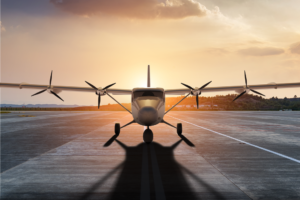 The 19 seat Eco Otter SX, which is being tested on the 2Zero programme, requires one megawatt to charge. Dr Ying explained the challenge: “To recharge a one megawatt airplane at an airport that’s currently supporting only 2.6 megawatt – that’s for passengers, the terminal and for all the power requirements in the airport – with one airplane that’s one megawatt, two airplanes would be two megawatt. Whether it’s charged by solar or wind or other type, the energy requirements for the infrastructure will be so much higher.”
The 19 seat Eco Otter SX, which is being tested on the 2Zero programme, requires one megawatt to charge. Dr Ying explained the challenge: “To recharge a one megawatt airplane at an airport that’s currently supporting only 2.6 megawatt – that’s for passengers, the terminal and for all the power requirements in the airport – with one airplane that’s one megawatt, two airplanes would be two megawatt. Whether it’s charged by solar or wind or other type, the energy requirements for the infrastructure will be so much higher.”
She said options which would be explored by the testing programmes, included connecting to the grid for stored energy in addition to solar power and power storage to meet the “huge energy storage and energy management requirement at the airport” for the new aircraft.
Models and simulations will explore route feasibility
The Orkney test flights will result in considerable time savings on crossings between the islands and lower costs associated with the new aircraft could also result in the possibility of opening up more routes, previously considered uneconomic for commercial operation. Dr Ying emphasised the importance of demonstrating that routes could be operated economically. “We’re studying that route, and if that works,” she added, “There are other routes that could be changed.”
Dr Ying says electric aviation could also improve the UK’s transport networks within the UK at a “fraction of the investment” needed to both build and maintain other modes such as road tunnels. The EEL has already carried out test flights in Maui, Hawai’i from one side of the island to another, with the potential to shorten a two hour car journey across windy, mountain roads to just 15 minutes.
Feasibility models and simulations will remove the requirement for physical testing of all routes and these will be provided by Ampaire’s partner, the University of Nottingham. Models and simulations can be created for different regions, from Scotland to southwest England. While travel between Devon and Cornwall’s towns and cities can take hours by road, Ying said there was the potential to reduce this to minutes, connecting both the local population with the rest of the UK and helping holidaymakers to get to their destinations faster.
Development of an Exeter to Cornwall route is one of the regional priorities for the 2Zero project, along with the creation of skilled jobs. Ying said the use of quieter, lower emission electric aircraft could also be a “win-win” for the south west. She said the aircraft could be used, “not just for travelling around but for potentially sightseeing and for the economic development in the area.”
Routes in the south west were previously served by Flybe, which had faced financial difficulties before the pandemic. Dr Ying said the inefficiency of Flybe’s aircraft over shorter routes would have contributed to the carrier’s collapse. She said the new aircraft would also offer an alternative to the current “hub and spoke” model of aviation, with larger airports connecting to smaller, regional operations. She added that the emerging electric aviation market could see more aircraft providing a greater number of direct routes, connecting smaller cities and towns which would be more convenient for passengers.
Overcoming noise barriers
Regional air travel could also speed up travel in areas where land-based travel has to take into account geographical features such as crossing the River Severn. “Regional air mobility really opens up a lot of these opportunities that current transportation just cannot do due to the economics and due to the carbon footprint, and also noise too.”
She said that the US could open “10 times as many airports” as were currently operational but that the noise from conventional aircraft frequently led to opposition from residents of properties nearby. “If the airplanes are quieter, or only have the propeller noise and not the combustion engine noise, then it’s quite different. I think the local residents would welcome that because it’s convenient for them to go places.”
Ampaire will be partnering with Loganair to examine the operational requirements for the Wick to Orkney route which includes adhering to a gate turnaround time of 20 minutes. Dr Ying explained that other operational aspects unique to electric aircraft would also be explored. While airlines do not currently require mechanics for refuelling, Ampaire’s operational model for a battery swap would be considered a Line Replaceable Unit and would require a mechanic.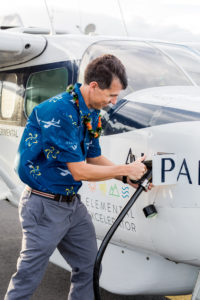
Dr Ying said common international standards will also need to be written and approved by aviation’s regulatory bodies which would have to take into account aspects including new components and the weight of batteries used for propulsion. “That’s one of the great things about the Future Flight Challenge programme – it allows us to take a look at the whole value chain, and all the requirements, so that we can work out all aspects, and enable electric aviation going forward.”
Regulators working with startups on global standards
Global standards are currently being discussed by working groups made up of government and industry. With certification for aircraft currently type-certified under different chapters for airframe and engines, she said the new standards would be needed for electric aircraft: “With electric airplanes, the electric components are much more integrated into the airplane than the combustion engines before.”
Ampaire is working with the CAA’s Regulatory Sandbox which aims to understand and “harmonise” international development between fast developing technology. “This is not just a bilateral between EASA and FAA, it could also be multilateral between the UK CAA or even including other CAA authorities such as China or Brazil,” she said.
“Organisations, such as the CAA and EASA realise that the technology is moving so fast, and as they don’t have people working within this technology, they have to work hand-in-hand with start-ups or technology developers to make sure that the rules they impose later on would be enabling, rather than trying to slow down the development process.”
Dr Ying says Ampaire estimates certification could be achieved around 2024-25, with the timeline dependent on the establishment of new standards and harmonisation of requirements between international regulatory bodies such as the FAA, EASA and CAA.
